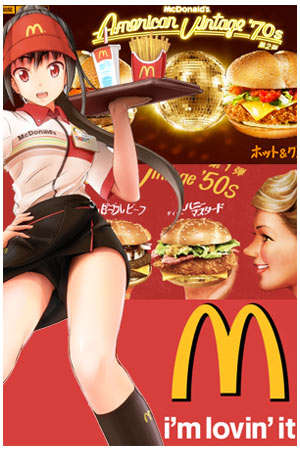The decades after WWII have seen some successful American businesses establish themselves in Japan, including Coca-Cola, Toys R Us and the Aflac duck. Another big success story has been McDonald's, which launched in 1971 to bring that company's brand of simulated quasi-food to the Japanese, and currently has more than 3000 restaurants here. Over the past few years, McDonald's and "Donald McDonald" (which is Ronald's name here) have brought us much entertainment in the form of Internet memes (Ran Ran Roo〜!) and bizarre fanart from Pixiv. McDonald's Japan won big when the yen crashed during the 2008 recession, allowing them to import tons of cheap beef from the U.S. and Australia and lower their prices, but when Prime Minister Shinzo "The Man Who Makes Our Anime Cheaper" Abe came to power a year ago, the yen returned to more normal territory which forced the company to raise its prices. To help re-invent itself, McDonald's has been offering "American Vintage" hamburgers, including 50s diner-style classic burgers and chili fries and now 70s-themed meals complete with people dancing disco style in the TV commercials.

McDonald's is selling "American Vintage" burgers.
There are quite a few differences between people in the U.S. and Japan, and one of them is, ah, body size. Japanese can seem impossibly thin to Americans, with an average height and weight of 171 cm/68 kg (5'7"/149 lbs) for men and 159 cm/51 kg (5'2"/114 lbs) for women, at the age of 30. In the early days of J-List we brought a 23-year-old female Japanese employee of ours to the U.S. to help work the San Diego Comic-Con, and she literally had to go to Gap Kids to find clothes that were small enough for her to buy. That said, there are actually some overweight Japanese, and the other day I watched an interesting show called Beauty Colosseum in which various "talents" (a catch-all word meaning actresses, comedians and singers) who had gained unwanted weight go on a big diet while the TV cameras record their weekly progress. Various diet methods were discussed during the show, like the kuromame diet consisting mainly of Japanese black beans, or the "hot yogurt diet" in which you eat a cup of yogurt that's been microwaved before each meal, to provide more calcium to your body, or something like that.

There are actually some overweight Japanese.
The Japanese are fond of designating certain days as special. May 4th is Ramune Day, commemorating the launch of the now-iconic Japanese soft drink all the way back in 1872, while August 2nd is パンツの日 pantsu no hi or "pantsu day," a day for celebrating everything that's wonderful about shimapan and other kinds of underwear. This Sunday (February 2nd) has been designated as "Twintail Day" by the Japan Twintail Association (which is a thing), and it's a great excuse to contemplate the awesomeness of "twintails" hair style, which are apparently called "pigtails" in English, though I've lived in Japan long enough that I needed to look that up. Many of the most popular anime characters have "twintail" hair, including Azusa from K-On!, Hatsune Miku, Kuroko from A Certain Scientific Railgun and of course Sailor Moon. Like "softcream" (what the Japanese call soft-serve ice cream), "virgin road" (a wedding aisle) and "guts pose" (someone pretending to show off their strength), twintails is a cute example of 和製英語 wasei-eigo or "made-in-Japan English."

Who's your favorite "twintail" character?
Today is a big day for PS Vita fans, with some great titles being released today, including the "definitive version" of the romance game Amagami, Disgaea 4, a Dragon Ball Z fighting game and deluxe edition of Rozen Maiden which comes with the actual watch from the series. We love all Sony's game platforms -- PSP, PS3, PSVita, and the soon-to-be-released-in-Japan PS4 -- because the games are all region-free, meaning otakus all around the world can play these great anime games, learn Japanese using them, and so on. Browse the new PSVita and other anime games now!

No comments:
Post a Comment